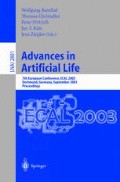Abstract
The question of conceptual representation has received considerable attention in philosophy, neuroscience and embodied evolved agents. Numerous theories on the interpretation of the term ‘representation’ exist, and many arguments have been made for and against the existence of representations in animate and animat agents. Our work studies this question in evolved artificial embodied agents in a quantitatively rigorous manner, for the first time. We develop two measures, based on information theory, to account for representations. These measures are studied by applying them to evolved agents performing a visual categorization, generalized XOR task. Our results show that having quantitative measures still leaves one with arbitrary “threshold values” decisions which permit wide freedom in determining the existence of representations. However, and more importantly, our results show that information-theoretic measures can still be used efficiently to identify discriminative neural patterns and internal structures that characterize a representation, if the latter is formed.
Access this chapter
Tax calculation will be finalised at checkout
Purchases are for personal use only
Preview
Unable to display preview. Download preview PDF.
References
Brooks, R.A.: Intelligence without representation. Artificial Intelligence 47, 139–159 (1991)
Cliff, D., Noble, J.: Knowledge-based vision and simple visual machines. Philosophical Transactions of the Royal Society: Biological Sciences 352, 1165–1175 (1997)
Pfeifer, R., Scheier, C.: Sensory-motor coordination: the metaphor and beyond. Robotics and Autonomous Systems, Special Issue on ”Practice and Future of Autonomous Agents” 20, 157–178 (1997)
Kosslyn, S.M., Chabris, C.F., Marsolek, C.J., Koenig, O.: Categorical versus coordinate spatial relations: computational analyses and computer simulations. Journal of Experimental Psychology: Human Perception and Performance 18, 562–577 (1992)
Cook, N.D.: Correlations between input and output units in neural networks. Cognitive Science 19, 563–574 (1995)
Kosslyn, S., Chabris, C., Baker, D.: Neural network models as evidence for different types of visual representations. Cognitive Science 19, 575–579 (1995)
Usher, M.: A statistical referential theory of content: Using information theory to account for misrepresentation. Mind and Language 16, 311–334 (2001)
Stanley, K.O., Miikkulainen, R.: Evolving neural networks through augmenting topologies. Evolutionary Computation 10, 99–127 (2002)
Gomez, F., Miikkulainen, R.: Incremental evolution of complex general behavior. Adaptive Behavior 5, 317–342 (1997)
Cover, T., Thomas, J.: The elements of information theory. Plenum Press, New York (1991)
Chechik, G., Tishby, N.: Extracting relevant structures with side information. In: Becker, S., Thrun, S., Obermayer, K. (eds.) Advances in Neural Information Processing Systems 15 (NIPS 2002). MIT Press, Cambridge (2003)
Author information
Authors and Affiliations
Editor information
Editors and Affiliations
Rights and permissions
Copyright information
© 2003 Springer-Verlag Berlin Heidelberg
About this paper
Cite this paper
Avraham, H., Chechik, G., Ruppin, E. (2003). Are There Representations in Embodied Evolved Agents? Taking Measures. In: Banzhaf, W., Ziegler, J., Christaller, T., Dittrich, P., Kim, J.T. (eds) Advances in Artificial Life. ECAL 2003. Lecture Notes in Computer Science(), vol 2801. Springer, Berlin, Heidelberg. https://doi.org/10.1007/978-3-540-39432-7_80
Download citation
DOI: https://doi.org/10.1007/978-3-540-39432-7_80
Publisher Name: Springer, Berlin, Heidelberg
Print ISBN: 978-3-540-20057-4
Online ISBN: 978-3-540-39432-7
eBook Packages: Springer Book Archive

